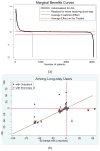Economics of individualization in comparative effectiveness research and a basis for a patient-centered health care
- PMID: 21601299
- PMCID: PMC3110511
- DOI: 10.1016/j.jhealeco.2011.03.004
Economics of individualization in comparative effectiveness research and a basis for a patient-centered health care
Abstract
The United States aspires to use information from comparative effectiveness research (CER) to reduce waste and contain costs without instituting a formal rationing mechanism or compromising patient or physician autonomy with regard to treatment choices. With such ambitious goals, traditional combinations of research designs and analytical methods used in CER may lead to disappointing results. In this paper, I study how alternate regimes of comparative effectiveness information help shape the marginal benefits (demand) curve in the population and how such perceived demand curves impact decision-making at the individual patient level and welfare at the societal level. I highlight the need to individualize comparative effectiveness research in order to generate the true (normative) demand curve for treatments. I discuss methodological principles that guide research designs for such studies. Using an example of the comparative effect of substance abuse treatments on crime, I use novel econometric methods to salvage individualized information from an existing dataset.
Copyright © 2011 Elsevier B.V. All rights reserved.
Figures




References
-
- ACES Testimony. Testimony on comparative effectiveness research by the Alliance of Comparative Effectiveness Stakeholders (ACES) to the Dr. Carolyn M. Clancy. Director Agency for Healthcare Research and Quality (AHRQ); 2009. Apr 3, [Accessed Jan 31, 2011]. http://www.ahrq.gov/about/nac/aces.htm.
-
- Arrow KJ, Debreu G. Existence of an equilibrium for a competitive economy. Econometrica. 1954;22:265–290.
-
- Arrow KJ. Uncertainty and the Welfare Economics of Medical Care. The American Economic Review. 1963;53(5):941–973.
-
- Basu A. Individualization at the heart of comparative effectiveness research: The time for i-CER has come. Medical Decision Making. 2009;29(6):N9–N11. - PubMed
-
- Basu A, Meltzer D. Value of information on preference heterogeneity and individualized care. Med Decis Making. 2007;27(2):112–127. - PubMed
Publication types
MeSH terms
Grants and funding
LinkOut - more resources
Full Text Sources

